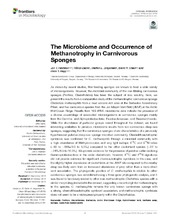The Microbiome and Occurrence of Methanotrophy in Carnivorous Sponges
Hestetun, Jon Thomassen; Dahle, Håkon; Jørgensen, Steffen Leth; Olsen, Bernt Rydland; Rapp, Hans Tore
Peer reviewed, Journal article
Published version

Åpne
Permanent lenke
https://hdl.handle.net/1956/15240Utgivelsesdato
2016-11-09Metadata
Vis full innførselSamlinger
Originalversjon
https://doi.org/10.3389/fmicb.2016.01781Sammendrag
As shown by recent studies, filter-feeding sponges are known to host a wide variety of microorganisms. However, the microbial community of the non-filtering carnivorous sponges (Porifera, Cladorhizidae) has been the subject of less scrutiny. Here, we present the results from a comparative study of the methanotrophic carnivorous sponge Cladorhiza methanophila from a mud volcano-rich area at the Barbados Accretionary Prism, and five carnivorous species from the Jan Mayen Vent Field (JMVF) at the Arctic Mid-Ocean Ridge. Results from 16S rRNA microbiome data indicate the presence of a diverse assemblage of associated microorganisms in carnivorous sponges mainly from the Gamma- and Alphaproteobacteria, Flavobacteriaceae, and Thaumarchaeota. While the abundance of particular groups varied throughout the dataset, we found interesting similarities to previous microbiome results from non-carnivorous deep sea sponges, suggesting that the carnivorous sponges share characteristics of a previously hypothesized putative deep-sea sponge microbial community. Chemolithoautotrophic symbiosis was confirmed for C. methanophila through a microbial community with a high abundance of Methylococcales and very light isotopic δ13C and δ15N ratios (-60 to -66‰/3.5 to 5.2‰) compared to the other cladorhizid species (-22 to -24‰/8.5 to 10.5‰). We provide evidence for the presence of putative sulfur-oxidizing Gammaproteobacteria in the arctic cladorhizids; however, δ13C and δ15N signatures did not provide evidence for significant chemoautotrophic symbiosis in this case, and the slightly higher abundance of cladorhizids at the JMVF site compared to the nearby deep sea likely stem from an increased abundance of prey rather than a more direct vent association. The phylogenetic position of C. methanophila in relation to other carnivorous sponges was established using a three-gene phylogenetic analysis, and it was found to be closely related to other non-methanotrophic Cladorhiza species with a similar morphology included in the dataset, suggesting a recent origin for methanotrophy in this species. C. methanophila remains the only known carnivorous sponge with a strong, chemolithoautotrophic symbiont association, and methanotrophic symbiosis does not seem to be a widespread property within the Cladorhizidae.
